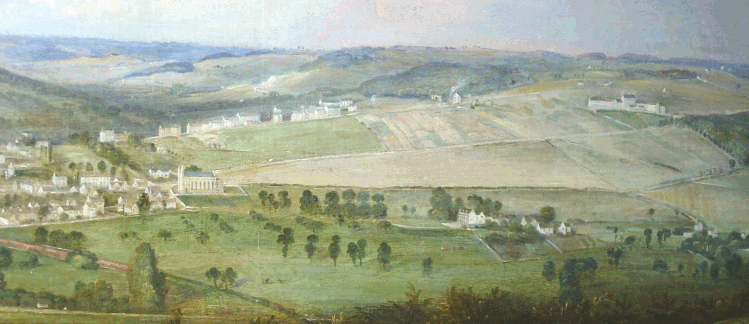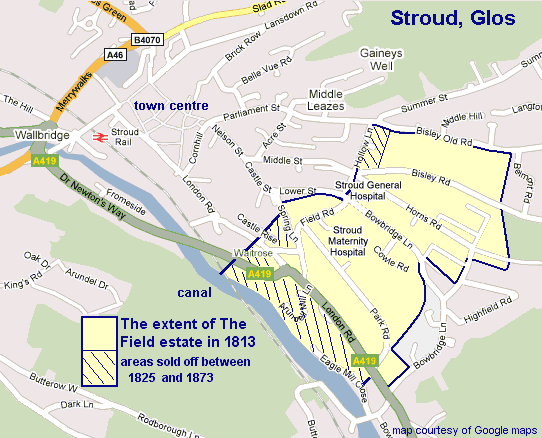Introduction
This is the Introduction to a series of essays about the land in Stroud (Glos, UK) on which our house was built. My earlier research (2009) concentrated on the absentee CALLAND and HAWKINS owners, with sideways excursions to the Bay of Bengal, Mayfair and a Wiltshire vicarage, using family letters, the internet, county archives, and contemporary newspapers (please click here to read those stories). In March 2010 it all took off again when a neighbour asked me "who was William Cowle". This question has turned into a separate research project on behalf of the Museum in the Park in Stroud, also known as The Cowle Museum from the bequest he left to the town. Here is a summary of the various stages of this later research (2010-12).
Up until 1873 Stroud's eastern side stopped at Hollow Lane and Lower Street, apart from the workhouse and cemetery which were built well out of town. In his Notes and Recollections of Stroud Fisher writes about strolling past Trinity Church across "The Fields" to 'the pleasant valley of The Horns', a walk well known to the young and remembered with quiet pleasure by many of the aged.
This same scene was part of a huge painting by Alfred N Smith in 1846, now hanging in Stroud's Museum in the Park, and it hardly changed until 1873. The Field mansion and its domestic buildings are in the centre of the picture, amongst Fisher's 'sheltering trees'; Trinity Church is on the left-hand (westerly) edge of the estate. The wide brown track was then called Hemlock Well Lane and it went from the bottom of Lower Street down across the turnpike to the mill. There were houses on the north side of Bisley Old Road, as you can see; the Union workhouse (up the hill on the right) was opened in 1839; the cemetery opposite was not started until the 1850s.

detail reproduced by kind permission of the Cowle Museum (also called the Museum in the Park)
Fisher goes on:
'But the spoiler in the shape of the builder of a whole town of small houses and shops, has been there ... Its bosky banks and sheltering trees have been cut down, to widen and straighten the roads through it, and with them have disappeared the choice places where children gathered wild flowers and collected the pretty spiral snail shells that lurked in the grass.'
This 'spoiler builder' must have been William Cowle, who bought the estate from the Hawkins family in February 1873. In November 1873 Cowle held a huge auction to sell off the whole hillside, about 60 acres between Bisley Old Road and the turnpike (just visible at the bottom of the painting), neatly divided into 103 building Lots. Today there are over 600 houses here (here is a map).
I am one of a group of residents who now want to find out who moved into this substantial Victorian development: where did they come from? what did they do for a living? how did the population change over the following 100 years? (We shall stop in the 1950s so as not to intrude into the lives of existing or recent residents). The results of our investigations will be given to the Cowle Museum in Stratford Park, as a resource for future researchers.
Overview
This new research phase is now (autumn 2010) starting to expand and will continue for some time.

Here is a modern map so you can get your bearings. A partial leafleting campaign has already resulted in a number of residents of The Field estate lending us their Title Deeds for copying and summarising, and stories are starting to emerge. We shall continue leafleting and talking to strangers in the street over the next few months to increase our digital collection of Deeds, photographs and stories. It might also involve holding meetings in the local pub but we can cope with that.
Since the research has expanded so quickly, here is a collection of links to the background structure already in existence, or planned. These stories will eventually form a separate Field Estate website but for now they are living here. The Stroud part of the story can be divided up into the following parts. Please click any of the links to see what happened [sorry, many are still work-in-progress (WIP)]
- What I found in 2009, including the Wiltshire vicarage family, the ARUNDELL/GREGORY link, the early mortgages, a description of the estate, and the the Deed of Mutual Covenant.
- 1560-1750 The early ARUNDELL estate in Stroud, and the HUCKVALEs
- 1750-1813 The transfer of The Field estate to Elizabeth (Gregory) HAWKINS
- 1820-60s The mortgages and early transactions of the Revd and Mrs John HAWKINS
- 1871-3 The will of the Revd John HAWKINS and purchase of The Field estate by William COWLE
- 1873 The auction of the Hawkins inheritance
- 1873 The original buyers and subsequent development
- A biography of William COWLE
- Useful maps of The Field, at various times [many more to come]
- The local censuses (from 1841 to 1901) and what they tell about the residents
- The local industries
- Other Stroud links, including Middle Street in 1881, the patients in Stroud Hospital at the time of the 1881 census. Transcripts of Stroud trade directories are in the History section of our website.
Here are the pre-auction personalities, and their stories [sorry, some are still WIP]:
- James ARUNDELL, the last local owner of The Field, who died in 1813.
- Elizabeth GREGORY, who at the age of 12 inherited the estate via her father John, an Oxfordshire vicar who had died in 1806, and whose family had connections via marriage to the Stroud Arundells.
- John Calland Cunningham Bennett Popkin HAWKINS - a Wiltshire vicar who married Elizabeth when she was 17 and he was a young curate. This chapter has sub-chapters on the Hawkins sons, and mid-Victorian Vicarage life.
- Samuel HAWKINS, JCCBPH's father - a successful Westminster solicitor who eloped with Sarah Calland in 1787.
- John CALLAND - Sarah's father and a very rich ex-East India Company employee who had sailed for Madras in 1750 at the age of 16. The CALLAND family's return to England is a separate chapter with its own links to the early Callands (1635-1750) and the later ones (1750-1900) .
And here is a link to the useful websites and contacts I have listed on another page.
It is accepted in all amateur research that extracts are only reproduced (with suitable acknowledgements) for personal or academic research purposes, and no money may change hands. I do not have a problem with that. If you would like to add any information to this story in the same spirit, or correct any errors, do please send me an email.


